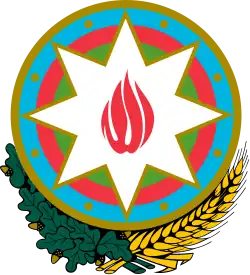Shoragel sultanate
Shoragel, Shuragel, Shorayel, or the Sultanate of Shoragel (Russian : Шурагел, Шурагельский султанат, Azerbaijani: Şörəyel sultanlığı) was a sultanate established around 1747, in the period of Afsharid dynasty in Persia. Its area was 1037.91 versts (1181.16 km²), and the population mainly consisted of Turkic tribes of Azerbaijan.[1]
The Sultanate of Shoragel Şörəyel sultanlığı (in Azerbaijani) Shoragel sultanlygy | |||||||||
|---|---|---|---|---|---|---|---|---|---|
| around 1747–1805 | |||||||||
| Status | Sultanate | ||||||||
| Capital | Ertik | ||||||||
| Official languages | Azerbaijani | ||||||||
| Religion | Islam | ||||||||
| Government | Absolute monarchy | ||||||||
| History | |||||||||
• Established | around 1747 | ||||||||
• Disestablished | 1805 | ||||||||
| Area | |||||||||
• Total | 1,037.91 km2 (400.74 sq mi) | ||||||||
| |||||||||
| Today part of | Armenia | ||||||||
History
The sultanate was located in the north-west of Iravan khanate at the foot of Alagoz (Alayaz) mountain. The sultanate was surrounded by the mountains separating the Kartli-Kakheti kingdom from the north, the Talyn and Seyidli-Agsaqqalli districts from the south, and the Pembek (also known as Pambak) province and Abaran districts from the east. The Arpachay River separated the Shorayel sultanate from the Kars pashalyk. The center of the sultanate was Ertik (Artik)
The “Review Book of Iravan Province” shows the existence of 172 villages in Shoragel Sanjak (together with Pambak Province). According to the information given during the reign of Nadir Shah, there were 109 villages in Shoragel district as a part of Iravan khanate.
In 1804, Russian troops invaded Shoragel resulting in the exodus of large portion of the local Muslim population and the final abolition of the Shoragel sultanate in 1805. Abandoned villages were eventually inhabited by the Armenian population resettled from Ottoman Empire. Those records were mentioned three decades later in the "Review of Russian possessions beyond the Caucasus" printed by Russian State Department for External Trade in 1836.[2]
В настоящее время жители Бамбако-Шурагельской дистанции разделяются на старожилов и новых поселенцев; к последним принадлежат все те, которые, после войны России с Турцией, перешли в 1829 году под власть Русского Правительства. При Камеральном описании в 1829 году исчислено в дистанции поселян: прежних – 1536 семейства с 5425 душами, и новых – 3148 семейств с 10575 душами мужского пола; всего же 4684 дома, содержащих 16000 душ мужского пола
At present, the inhabitants of the Bambako-Shuragel distance are divided into old-timers and new settlers; to the latter belong all those who, after the war between Russia and Turkey, passed in 1829 under the authority of the Russian Government. The count villagers in the region was calculated in the Office description of 1829: the former - 1536 families with 5425 souls, and the new ones - 3148 families with 10575 male souls; there are 4,684 houses in all, containing 16,000 male souls.
Part of the Shoragel residents, mainly Karapapakh Turks, left their lands in the wake of the Russo-Turkish war in 1807 and found refuge in the territories of Iravan khanate and Kars pashalyk.
In 1858, the Department of the General Staff of the Russian Empire notes that the Armenian population of Ottoman Empire and Persia continue moving to the empty territories of Araks, Gokche lake (currently known as Sevan) and Shuragel.[3] Both Araks and Gokche lake were the former territories of Erivan khanate which was conquered and demolished like Shorayel (or Shoragel) sultanate in the same time period.
Rulers
- Budaq sultan sultan is the last ruler of the Shoragel sultanate. On October 20, 1805, he signed a document with Pavel Tsitsianov on Shoragel's permanent subordination to Russia in Ganja city. Budag sultan had three sons named Gara Mohammad bey, Hamid bey, Khalil bey.
See also
References
- III отдѣлъ: Статистическiя свѣдѣнiя. — Пространство и населенiе Кавказа, стр. 44–46. // Кавказскiй календарь на 1901 годь (LVI годь). Издань по распоряженiю Главноначальствующаго гражданскою частiю на Кавказѣ, при Закавказскомь Статистическомь Комитетѣ, подь редакцiею Члена того же Комитета, Статскаго Совѣтника Е. Кондратенко. Тифлисъ: Типографiя М. Шарадзе и К°, 1900 г.
- Обозрение российских владений за Кавказом, в статистическом, этнографическом, топографическом и финансовом отношениях. Часть II. Санкт-Петербург: Типография Департамента Внешней Торговли. 1836. p. 303. ISBN 978-5-4460-2609-8.
- ВОЕННО-СТАТИСТИЧЕСКОЕ ОБОЗРЕНИЕ РОССИЙСКОЙ ИМПЕРИИ. Т. 16, Ч. 6. ЭРИВАНСКАЯ ГУБЕРНИЯ. Санкт-Петербург: Типография Департамента Генерального Штаба. 1836. pp. 146–147.
Sources
- Arzumanli, Vagif; Mustafa, Nazim (1998). Tarixin qara səhifələri: Deportasiya. Soyqırım. Qaçqınlıq. Qartal. pp. 18–24.
